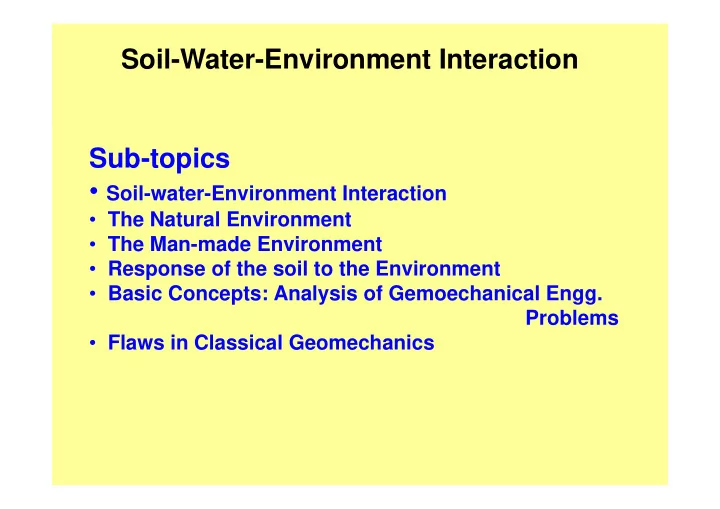

Soil-Water-Environment Interaction Sub-topics • Soil-water-Environment Interaction • The Natural Environment • The Man-made Environment • Response of the soil to the Environment • Basic Concepts: Analysis of Gemoechanical Engg. Problems • Flaws in Classical Geomechanics
Soil-Water-Environment Interaction The Natural Man Made Geomicrobiosphere Environment Environment The Particle Energy Environmental Field Theory Geotechnical Problems Requires knowledge from other Disciplines Understanding of (Bacteriology/Biology, Chemical Soil response to Engg./Climatology/ Geohydrology/Geophysics/Geochemistry/ Environments Hydrogeology/Mechanics/Microgeology/Physico (Short & long-term) -Chemistry/SoilScience/Soil Engineering/Toxicology)
The Natural Environment Atmos phere ( variable amount of vapour/dust ) Bios phere ( all plants & animal life ) Oxygen Cycle Nitrogen Cycle The Cycle of Nature Carbon Cycle Hydro sphere (Water in oceans, rivers, lakes, aquifers, ice, clouds) Litho sphere (stone, rocks and soils) Geomicrobiosphere Ecosphere ( to study the characteristics of tree, vegetation, roots and bacterial activities in the soil and water and its overall response)
The Cycle of Nature Oxygen Cycle (O 2 is found in combination with Si & Al) Alumino silicates, Metallic oxides, Carbonates, Sulfates, Nitrates, Phosphates) Nitrogen Cycle (Transfer of Nitrogen between atmosphere, biosphere, lithosphere & hydrosphere in various forms) Nitrogen fixation, Carbon Cycle (oxidation of carbon containing material) CO 2 formation required for photosynthesis
Man-made Environment Solid Liquid Agricultural wastes Human and Animal wastes Industrial wastes Mine wastes……Acid mine waste (due to oxidation of Iron Sulphide (FeS 2 ) or Pyrites to H 2 SO 4 ) Nuclear wastes Construction Effects (Blasting/Dewatering/debris…)
Soil Response to Environments Soil structures (on/in/with) Pore fluid characteristics Soil-heat Soil-Chemical Soil Bacteria Soil-Root Soil-Electrical Soil-Liquid (water)
Pollution Processes & Soil-Pollution Interaction Pollution Air Pollution Water Pollution Land Pollution Smoke & Odor Contaminated surface Open dumps Incineration and ground water Chemical wastes Industrial gases Chemical wastes Power plant wastes Radiation Oil pollution Septic tanks Sewage odors Vehicle Silt in water Chemicals in soil & exhaust Nutrients in runoff food Pesticide sprays Erosion Dust Agricultural manure Effect on Engineering Behavior Changes in: Changes in: Changes in: Hydraulic & Thermal workability & Durability Accelearted weathering conductivities Corrosion of: of concrete Soil compaction soil-water system bldgs./bridges/pavements Settlements Hydraulic conductivity Acid rains Soil stability Hydraulic structures Seepage characteristics Corrosion
Basic concepts of Analysis Most geotechnical projects occur in nature Long-term phenomenon Soil is more sensitive and susceptible to environment than any other construction material Loading may greatly affect soil properties ( crushing ) but not the only parameter to be considered Think of other factors: Heat Mositure (wet/Dry) Pollution intrusion
Classical Soil Mechanics: Some flaws 1. Specific gravity and Atterberg’s limits are constant 2. Void ratio and porosity as indicators of soil deformation 3. Water in the soil mass is mainly gravity water (need to consider Environmental water & its solid and gaseous phases as well) 4. Flow through a soil mass is only due to hydrostatic potential Water in soil responds to the imposition of any energy field and exhibits coupling affect(s) (need to consider thermal/electrical/magnetic/chemical effects) Flux velocity = Coefficient of Energy Conductivity × Energy gradient 5. Constitutive models are arbitrarily chosen. Stress-strain relationship
Major assumptions that deserve careful attention Constant seepage velocity Coupled flow process: (moisture and heat flow, Flow of fines from the soil mass) Saturated versus unsaturated condition (causes of creation of unsaturated state of the soil, characterization) Cation exchange capacity (CEC) of geomaterials and its effect on soil-contaminant interaction Bio- / Chemico- degradation of geomaterials (mainly Organic soils) due to prolonged exposure to man-made environment
Soil Classification: Is this Acceptable ??? Grain-size distribution Present Soil Consistency (moisture content) scenario LL PL (Parameters) PI % Passing #200 Sieve Specific surface Proposed pore fluid characteristics (pH) scenario Ion-exchange capacity (CEC) Sorption Characteristics (Parameters) (Absorption & adsorption) Electrical properties (Conductivity & Dielectric constant Thermal diffusivity, resistivity, heat capacity
Recommend
More recommend